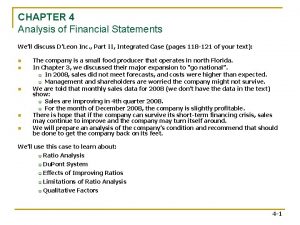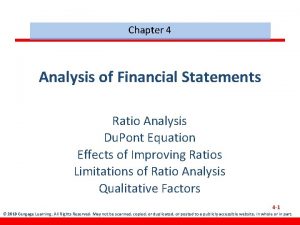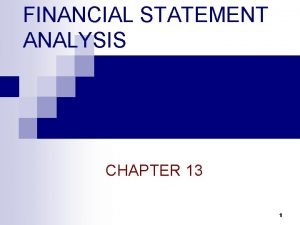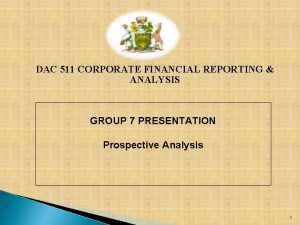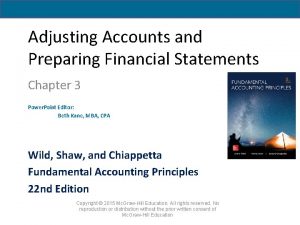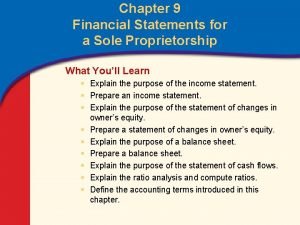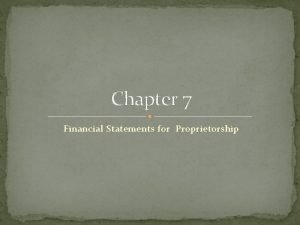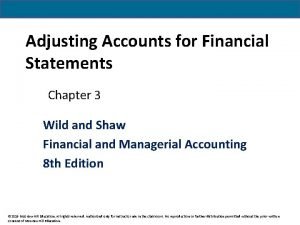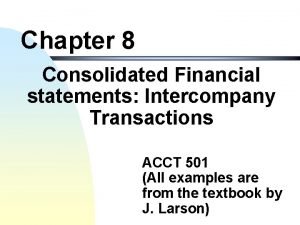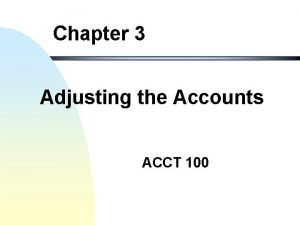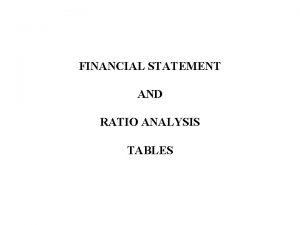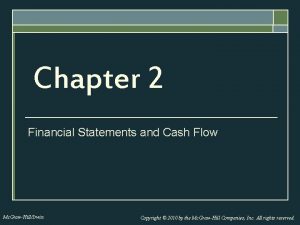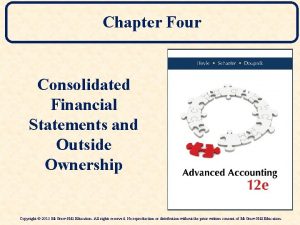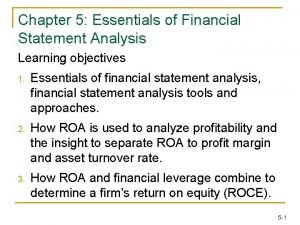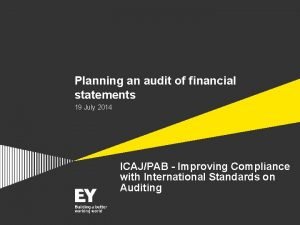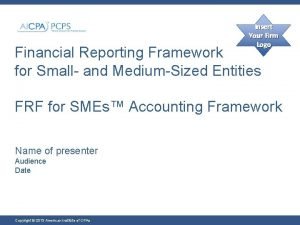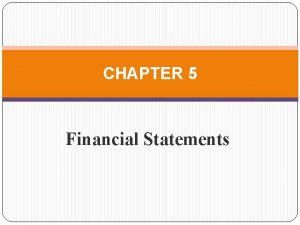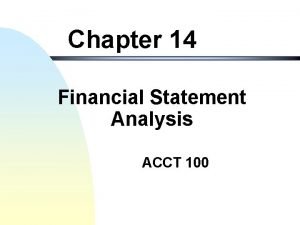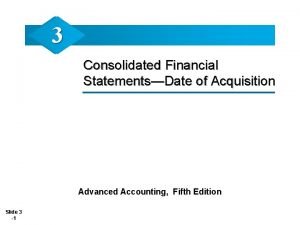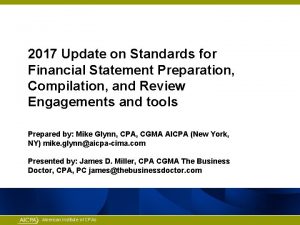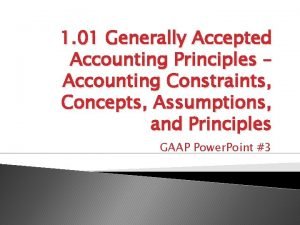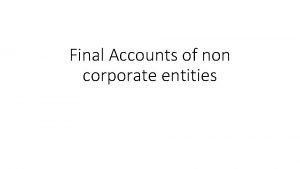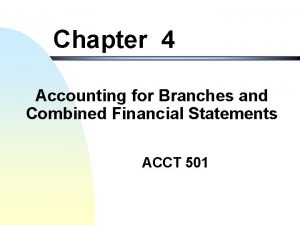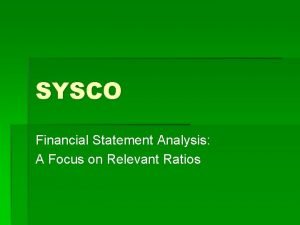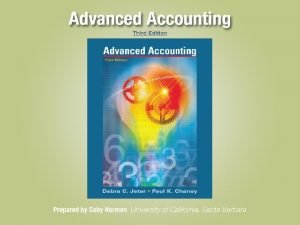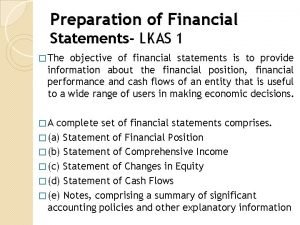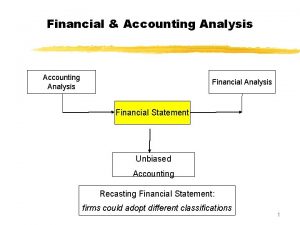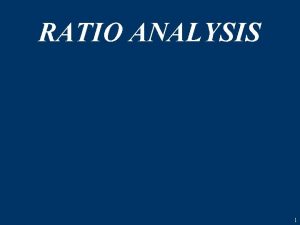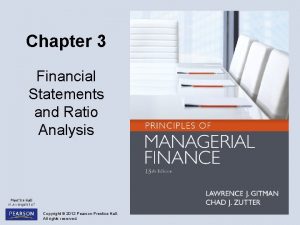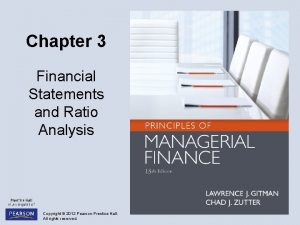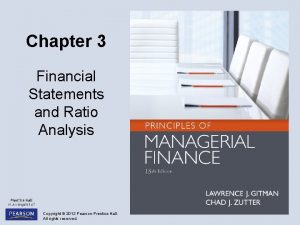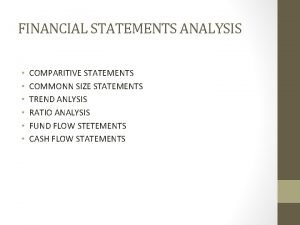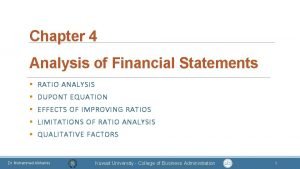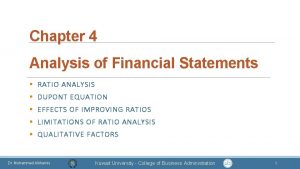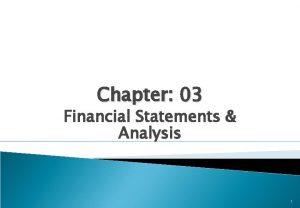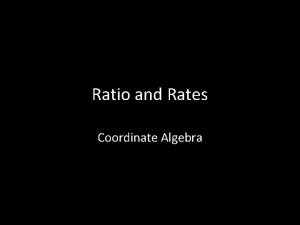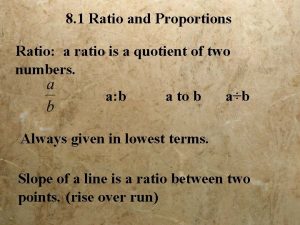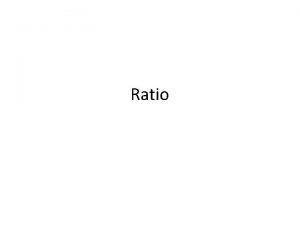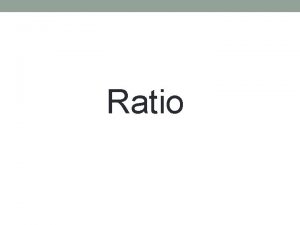Chapter 3 Financial Statements and Ratio Analysis Copyright


















































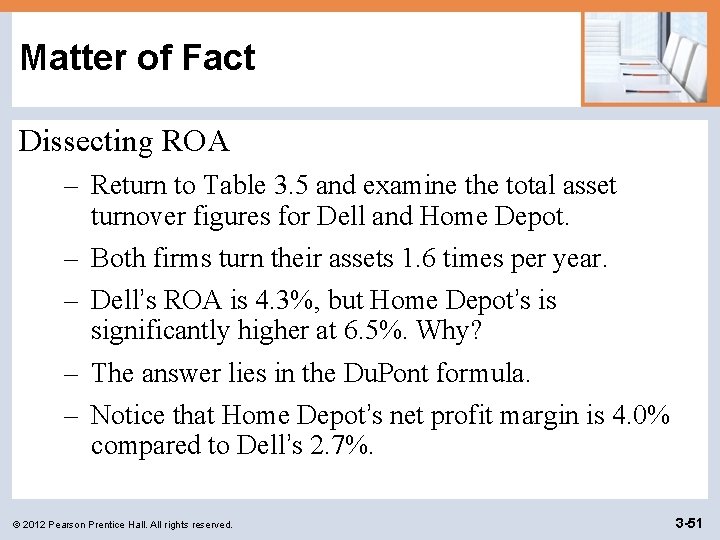
- Slides: 51

Chapter 3 Financial Statements and Ratio Analysis Copyright © 2012 Pearson Prentice Hall. All rights reserved.

The Stockholders’ Report • Generally accepted accounting principles (GAAP) are the practice and procedure guidelines used to prepare and maintain financial records and reports; authorized by the Financial Accounting Standards Board (FASB). • The Sarbanes-Oxley Act of 2002, passed to eliminate the many disclosure and conflict of interest problems of corporations, established the Public Company Accounting Oversight Board (PCAOB), which is a not-for-profit corporation that overseas auditors. © 2012 Pearson Prentice Hall. All rights reserved. 3 -2

The Four Key Financial Statements: The Income Statement • The income statement provides a financial summary of a company’s operating results during a specified period. • Although they are prepared quarterly for reporting purposes, they are generally computed monthly by management and quarterly for tax purposes. © 2012 Pearson Prentice Hall. All rights reserved. 3 -3

Table 3. 1 Bartlett Company Income Statements ($000) © 2012 Pearson Prentice Hall. All rights reserved. 3 -4

The Four Key Financial Statements: The Balance Sheet • The balance sheet presents a summary of a firm’s financial position at a given point in time. • The statement balances the firm’s assets (what it owns) against its financing, which can be either debt (what it owes) or equity (what was provided by owners). © 2012 Pearson Prentice Hall. All rights reserved. 3 -5

Table 3. 2 a Bartlett Company Balance Sheets ($000) © 2012 Pearson Prentice Hall. All rights reserved. 3 -6

Table 3. 2 b Bartlett Company Balance Sheets ($000) © 2012 Pearson Prentice Hall. All rights reserved. 3 -7

The Four Key Financial Statements: Statement of Retained Earnings The statement of retained earnings reconciles the net income earned during a given year, and any cash dividends paid, with the change in retained earnings between the start and the end of that year. © 2012 Pearson Prentice Hall. All rights reserved. 3 -8

Table 3. 3 Bartlett Company Statement of Retained Earnings ($000) for the Year Ended December 31, 2012 © 2012 Pearson Prentice Hall. All rights reserved. 3 -9

The Four Key Financial Statements: Statement of Cash Flows • The statement of cash flows provides a summary of the firm’s operating, investment, and financing cash flows and reconciles them with changes in its cash and marketable securities during the period. • This statement not only provides insight into a company’s investment, financing and operating activities, but also ties together the income statement and previous and current balance sheets. © 2012 Pearson Prentice Hall. All rights reserved. 3 -10

Table 3. 4 Bartlett Company Statement of Cash Flows ($000) for the Year Ended December 31, 2012 © 2012 Pearson Prentice Hall. All rights reserved. 3 -11

Consolidating International Financial Statements (cont. ) • Equity accounts, on the other hand, are translated into dollars by using the exchange rate that prevailed when the parent’s equity investment was made (the historical rate). • Retained earnings are adjusted to reflect each year’s operating profits (or losses). © 2012 Pearson Prentice Hall. All rights reserved. 3 -12

Using Financial Ratios: Interested Parties • Ratio analysis involves methods of calculating and interpreting financial ratios to analyze and monitor the firm’s performance. • Current and prospective shareholders are interested in the firm’s current and future level of risk and return, which directly affect share price. • Creditors are interested in the short-term liquidity of the company and its ability to make interest and principal payments. • Management is concerned with all aspects of the firm’s financial situation, and it attempts to produce financial ratios that will be considered favorable by both owners and creditors. © 2012 Pearson Prentice Hall. All rights reserved. 3 -13

Using Financial Ratios: Types of Ratio Comparisons • Cross-sectional analysis is the comparison of different firms’ financial ratios at the same point in time; involves comparing the firm’s ratios to those of other firms in its industry or to industry averages • Benchmarking is a type of cross-sectional analysis in which the firm’s ratio values are compared to those of a key competitor or group of competitors that it wishes to emulate. • Comparison to industry averages is also popular, as in the following example. © 2012 Pearson Prentice Hall. All rights reserved. 3 -14

Using Financial Ratios: Types of Ratio Comparisons (cont. ) Caldwell Manufacturing’s calculated inventory turnover for 2012 and the average inventory turnover were as follows: Caldwell Manufacturing Industry average © 2012 Pearson Prentice Hall. All rights reserved. Inventory turnover, 2012 14. 8 9. 7 3 -15

Table 3. 5 Financial Ratios for Select Firms and Their Industry Median Values © 2012 Pearson Prentice Hall. All rights reserved. 3 -16

Using Financial Ratios: Types of Ratio Comparisons (cont. ) • Time-series analysis is the evaluation of the firm’s financial performance over time using financial ratio analysis • Comparison of current to past performance, using ratios, enables analysts to assess the firm’s progress. • Developing trends can be seen by using multiyear comparisons. • The most informative approach to ratio analysis combines cross-sectional and time-series analyses. © 2012 Pearson Prentice Hall. All rights reserved. 3 -17

Figure 3. 1 Combined Analysis © 2012 Pearson Prentice Hall. All rights reserved. 3 -18

Using Financial Ratios: Cautions about Using Ratio Analysis 1. Ratios that reveal large deviations from the norm merely indicate the possibility of a problem. 2. A single ratio does not generally provide sufficient information from which to judge the overall performance of the firm. 3. The ratios being compared should be calculated using financial statements dated at the same point in time during the year. 4. It is preferable to use audited financial statements. 5. The financial data being compared should have been developed in the same way. 6. Results can be distorted by inflation. © 2012 Pearson Prentice Hall. All rights reserved. 3 -19

Ratio Analysis Liquidity Ratios Current ratio = Current assets ÷ Current liabilities The current ratio for Bartlett Company in 2012 is: $1, 223, 000 ÷ $620, 000 = 1. 97 © 2012 Pearson Prentice Hall. All rights reserved. 3 -20

Matter of Fact Determinants of liquidity needs – Large enterprises generally have well established relationships with banks that can provide lines of credit and other short-term loan products in the event that the firm has a need for liquidity. – Smaller firms may not have the same access to credit, and therefore they tend to operate with more liquidity. © 2012 Pearson Prentice Hall. All rights reserved. 3 -21

Ratio Analysis (cont. ) Liquidity Ratios The quick ratio for Bartlett Company in 2012 is: © 2012 Pearson Prentice Hall. All rights reserved. 3 -22

Ratio Analysis (cont. ) Activity Ratios Inventory turnover = Cost of goods sold ÷ Inventory Applying this relationship to Bartlett Company in 2012 yields: $2, 088, 000 ÷ $289, 000 = 7. 2 © 2012 Pearson Prentice Hall. All rights reserved. 3 -23

Ratio Analysis (cont. ) Activity Ratios Average Age of Inventory = 365 ÷ Inventory turnover For Bartlett Company, the average of inventory in 2012 is: 365 ÷ 7. 2 = 50. 7 days © 2012 Pearson Prentice Hall. All rights reserved. 3 -24

Ratio Analysis (cont. ) Activity Ratios The average collection period for Bartlett Company in 2012 is: © 2012 Pearson Prentice Hall. All rights reserved. 3 -25

Table 3. 6 Financial Statements Associated with Patty’s Alternatives © 2012 Pearson Prentice Hall. All rights reserved. 3 -26

Ratio Analysis (cont. ) Debt Ratios Debt ratio = Total liabilities ÷ Total assets The debt ratio for Bartlett Company in 2012 is $1, 643, 000 ÷ $3, 597, 000 = 0. 457 = 45. 7% © 2012 Pearson Prentice Hall. All rights reserved. 3 -27

Ratio Analysis (cont. ) Debt Ratios Times interest earned ratio = EBIT ÷ Interest Expense The figure for earnings before interest and taxes (EBIT) is the same as that for operating profits shown in the income statement. Applying this ratio to Bartlett Company yields the following 2012 value: $418, 000 ÷ $93, 000 = 4. 5 © 2012 Pearson Prentice Hall. All rights reserved. 3 -28

Ratio Analysis (cont. ) Debt Ratios Fixed-Payment coverage Ratio (FPCR) Applying the formula to Bartlett Company’s 2012 data yields: © 2012 Pearson Prentice Hall. All rights reserved. 3 -29

Table 3. 7 Bartlett Company Common-Size Income Statements © 2012 Pearson Prentice Hall. All rights reserved. 3 -30

Ratio Analysis (cont. ) Profitability Ratios Bartlett Company’s gross profit margin for 2012 is: © 2012 Pearson Prentice Hall. All rights reserved. 3 -31

Ratio Analysis (cont. ) Profitability Ratios Operating profit margin = Operating profits ÷ sales Bartlett Company’s operating profit margin for 2012 is: $418, 000 ÷ $3, 074, 000 = 13. 6% © 2012 Pearson Prentice Hall. All rights reserved. 3 -32

Ratio Analysis (cont. ) Profitability Ratios Net profit margin = Earnings available for common stockholders ÷ Sales Bartlett Company’s net profit margin for 2012 is: $221, 000 ÷ $3, 074, 000 = 0. 072 = 7. 2% © 2012 Pearson Prentice Hall. All rights reserved. 3 -33

Ratio Analysis (cont. ) Profitability Ratios Bartlett Company’s earnings per share (EPS) in 2012 is: $221, 000 ÷ 76, 262 = $2. 90 © 2012 Pearson Prentice Hall. All rights reserved. 3 -34

Ratio Analysis (cont. ) Profitability Ratios Return on total assets (ROA) = Earnings available for common stockholders ÷ Total assets Bartlett Company’s return on total assets in 2012 is: $221, 000 ÷ $3, 597, 000 = 0. 061 = 6. 1% © 2012 Pearson Prentice Hall. All rights reserved. 3 -35

Ratio Analysis (cont. ) Profitability Ratios Return on Equity (ROE) = Earnings available for common stockholders ÷ Common stock equity This ratio for Bartlett Company in 2012 is: $221, 000 ÷ $1, 754, 000 = 0. 126 = 12. 6% © 2012 Pearson Prentice Hall. All rights reserved. 3 -36

Ratio Analysis (cont. ) Market Ratios Price Earnings (P/E) Ratio = Market price per share of common stock ÷ Earnings per share If Bartlett Company’s common stock at the end of 2012 was selling at $32. 25, using the EPS of $2. 90, the P/E ratio at year-end 2012 is: $32. 25 ÷ $2. 90 = 11. 1 © 2012 Pearson Prentice Hall. All rights reserved. 3 -37

Ratio Analysis (cont. ) Market Ratios where, © 2012 Pearson Prentice Hall. All rights reserved. 3 -38

Ratio Analysis (cont. ) Substituting the appropriate values for Bartlett Company from its 2012 balance sheet, we get: Substituting Bartlett Company’s end of 2012 common stock price of $32. 25 and its $23. 00 book value per share of common stock (calculated above) into the M/B ratio formula, we get: $32. 25 ÷ $23. 00 = 1. 40 © 2012 Pearson Prentice Hall. All rights reserved. 3 -39

Predicting Corporate Bankruptcy: The Z-score model Many potential lenders use credit scoring models to assess the creditworthiness of prospective borrowers. The general idea is to find factors that enable the lenders to discriminate between good and bad credit risks. Edward Altman has developed a model using financial statement ratios and multiple discriminant analyses to predict bankruptcy for publicly traded manufacturing firms

Predicting Corporate Bankruptcy: The Z -score model (continued) The resultant model is of the form: Z = 3. 3(EBIT/Total assets) + 1. 2(Net working capital/Total assets) + 1. 0(Sales/Total assets) + 0. 6(Market value of equity/Book value of debt) + 1. 4(Accumulated retained earnings/Total assets) where Z is an index of bankruptcy. Bankruptcy would be predicted if Z 1. 81 and nonbankruptcy if Z 2. 99.

Predicting Corporate Bankruptcy: The Z -score model (continued) Altman uses a revised model to make it applicable for private firms and non-manufacturers. The resulting model is: Z = 6. 56(Net working capital/Total assets) + 3. 26(Accumulated retained earnings/Total assets) + 1. 05(EBIT/Total assets) + 6. 72(Book value of equity/Total liabilities) where Z 1. 23 Z and Z 1. 23 indicates a bankruptcy prediction. 2. 90 indicates a grey area, 2. 90 indicates no bankruptcy.

Table 3. 8 a Summary of Bartlett Company Ratios © 2012 Pearson Prentice Hall. All rights reserved. 3 -43

Table 3. 8 b Summary of Bartlett Company Ratios © 2012 Pearson Prentice Hall. All rights reserved. 3 -44

Du. Pont System of Analysis • The Du. Pont system of analysis is used to dissect the firm’s financial statements and to assess its financial condition. • It merges the income statement and balance sheet into two summary measures of profitability. • The Modified Du. Pont Formula relates the firm’s ROA to its ROE using the financial leverage multiplier (FLM), which is the ratio of total assets to common stock equity: • ROA and ROE as shown in the series of equations on the following slide. © 2012 Pearson Prentice Hall. All rights reserved. 3 -45

Du. Pont System of Analysis • The Du. Pont system first brings together the net profit margin, which measures the firm’s profitability on sales, with its total asset turnover, which indicates how efficiently the firm has used its assets to generate sales. ROA = Net profit margin Total asset turnover • Substituting the appropriate formulas into the equation and simplifying results in the formula given earlier, © 2012 Pearson Prentice Hall. All rights reserved. 3 -46

Du. Pont System of Analysis (cont. ) When the 2012 values of the net profit margin and total asset turnover for Bartlett Company, calculated earlier, are substituted into the Du. Pont formula, the result is: ROA = 7. 2% 0. 85 = 6. 1% © 2012 Pearson Prentice Hall. All rights reserved. 3 -47

Du. Pont System of Analysis: Modified Du. Pont Formula • The modified Du. Pont Formula relates the firm’s return on total assets to its return on common equity. The latter is calculated by multiplying the return on total assets (ROA) by the financial leverage multiplier (FLM), which is the ratio of total assets to common stock equity: ROE = ROA FLM • Substituting the appropriate formulas into the equation and simplifying results in the formula given earlier, © 2012 Pearson Prentice Hall. All rights reserved. 3 -48

Du. Pont System of Analysis: Modified Du. Pont Formula (cont. ) Substituting the values for Bartlett Company’s ROA of 6. 1 percent, calculated earlier, and Bartlett’s FLM of 2. 06 ($3, 597, 000 total assets ÷ $1, 754, 000 common stock equity) into the modified Du. Pont formula yields: ROE = 6. 1% 2. 06 = 12. 6% © 2012 Pearson Prentice Hall. All rights reserved. 3 -49

Figure 3. 2: Du. Pont System of Analysis © 2012 Pearson Prentice Hall. All rights reserved. 3 -50

Matter of Fact Dissecting ROA – Return to Table 3. 5 and examine the total asset turnover figures for Dell and Home Depot. – Both firms turn their assets 1. 6 times per year. – Dell’s ROA is 4. 3%, but Home Depot’s is significantly higher at 6. 5%. Why? – The answer lies in the Du. Pont formula. – Notice that Home Depot’s net profit margin is 4. 0% compared to Dell’s 2. 7%. © 2012 Pearson Prentice Hall. All rights reserved. 3 -51
 Financial statements and ratio analysis chapter 3
Financial statements and ratio analysis chapter 3 Financial statements and ratio analysis chapter 3
Financial statements and ratio analysis chapter 3 Chapter 4 analysis of financial statements
Chapter 4 analysis of financial statements Chapter 4 analysis of financial statements
Chapter 4 analysis of financial statements Financial analysis for banks
Financial analysis for banks Cffa finance formula
Cffa finance formula Analysis of financial statements
Analysis of financial statements Prospective analysis financial statements
Prospective analysis financial statements Fees earned debit or credit
Fees earned debit or credit Chapter 9 financial statements for a sole proprietorship
Chapter 9 financial statements for a sole proprietorship Sole proprietorship financial statements
Sole proprietorship financial statements Adjusting accounts for financial statements
Adjusting accounts for financial statements Chapter 8 separate financial statements
Chapter 8 separate financial statements Working with financial statements chapter 3
Working with financial statements chapter 3 Adjusting the accounts chapter 3
Adjusting the accounts chapter 3 Adjusting entry accrued expense
Adjusting entry accrued expense Boeing financial ratios
Boeing financial ratios Financial ratio analysis
Financial ratio analysis 2-2 journal: financial statements and cash flow management
2-2 journal: financial statements and cash flow management Unit 13 accounting and financial statements
Unit 13 accounting and financial statements Partial equity method consolidation worksheet
Partial equity method consolidation worksheet Acid test ratio and quick ratio
Acid test ratio and quick ratio Phenotypic ratio of dihybrid cross
Phenotypic ratio of dihybrid cross Current ratio and quick ratio
Current ratio and quick ratio Purpose of financial reporting
Purpose of financial reporting Planning an audit of financial statements
Planning an audit of financial statements Sample notes to financial statements for small entities
Sample notes to financial statements for small entities Financial statement translation example
Financial statement translation example What are the 5 types of financial statements?
What are the 5 types of financial statements? Acct 100
Acct 100 Parsimonious method of forecasting
Parsimonious method of forecasting Consolidated financial statements date of acquisition
Consolidated financial statements date of acquisition Ssars 21 engagement letter example
Ssars 21 engagement letter example Which item is a constraint in financial accounting
Which item is a constraint in financial accounting Ias 27
Ias 27 Standardized balance sheet
Standardized balance sheet Final accounts of non corporate entities
Final accounts of non corporate entities Home office and branch accounting
Home office and branch accounting Chapter 5 accounting for merchandising operations answers
Chapter 5 accounting for merchandising operations answers Four financial statements
Four financial statements Ifrs 17 effective date
Ifrs 17 effective date Sysco financial statements
Sysco financial statements Four primary financial statements
Four primary financial statements Financial statements tools
Financial statements tools Translating financial statements
Translating financial statements Sole trader financial statements example
Sole trader financial statements example A company has sales of 695 000 and cost of goods
A company has sales of 695 000 and cost of goods Special purpose financial statements
Special purpose financial statements Lkas 1 pdf
Lkas 1 pdf Operating roa
Operating roa Asc 830
Asc 830 Structure of financial statement
Structure of financial statement


